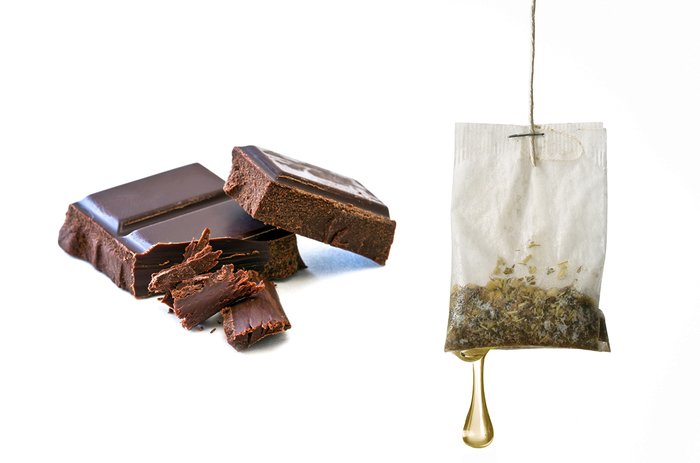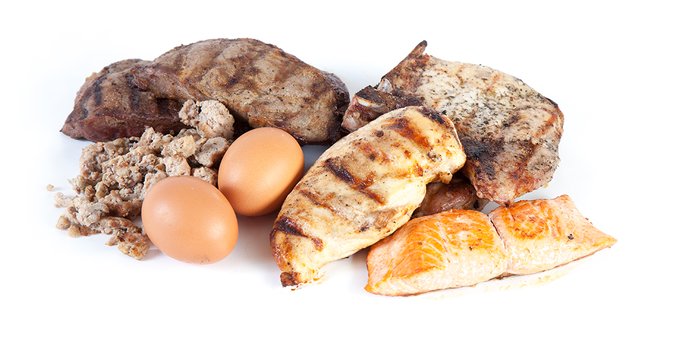As the human population continues to grow, the number of new diets seems to grow with it. To help you sort through the options, here is my take on the Ketogenic Diet and three lesser-known diets: the Anti-Inflammatory Diet, the "if it fits your macros diet," and the Blood-Type Diet. I’ve also got an update for you on the “oldie, but goodie” Atkins Diet.
The Ketogenic Diet
The purpose of this diet is to get your body into ketosis, the state in which your body shifts its primary fuel source from glucose to fatty acids and ketone bodies.
Your body (or most bodies, I should say) has a nearly limitless supply of stored fats it can transform into energy-producing fatty acids and ketone bodies. This diet helps you retrain your body to essentially burn fat for energy. Once it makes that switch, say hello to hella fat loss!
A keto diet is a very high-fat, moderate-protein, very low-carbohydrate meal plan in which you get 70-75 percent of your calories from fat, 15-20 percent from protein, and 5-10 percent from carbohydrates.
Pros: If you can get past the dreaded "keto flu" and survive the weeks it takes to enter ketosis, you should experience outstanding weight loss and a positive effect on your blood cholesterol and triglyceride levels.[1]
Cons: Getting past keto flu and into ketosis is hard. Why? Because of carbs. Most mortals lack the willpower to avoid all carbs, all the time. But sneak in even a tiny amount and you can knock your body out of ketosis. The 3-5 days it can take to get past keto flu and into ketosis again is hard to take and puts a giant "pause" on the weight-loss benefits you might have been enjoying. Keto flu aside, a ketogenic diet may not give you the fuel you need to perform at your best.[2,3] If your goal is improving rep PRs, 1RMs, or sprint times, this diet may not be for you.
Anti-Inflammatory Diet
The Anti-Inflammatory Diet, developed by Dr. Andrew Weil, looks very similar to the Mediterranean diet, except for a few extras, including dark chocolate and green tea. This is really more of an approach to eating than an actual diet, but that doesn't mean it can't help you lose weight.
The foundation of Dr. Weil's approach rests in the idea that inflammation is a root cause of many serious diseases, including heart disease, cancer, and Alzheimer's. Weil's dietary approach stresses consumption of antioxidants, which have numerous health benefits, and phytochemicals, which have anti-inflammatory and cancer-fighting properties. The approach also advises people on how to minimize consumption of toxins.[4]

Weil's approach allows people to consume 2,000-3,000 calories per day, depending on age, gender, size, and activity level. It recommends the following macronutrient ratio, with some of each macronutrient consumed at each meal:
- 40-50 percent of your daily calories from carbohydrates
- 30 percent of your calories from fat
- 20-30 percent of your calories from protein
Weil also stresses:
- Consumption of fresh, wholesome foods to reap the benefits of natural phytochemicals and their anti-inflammatory properties
- A focus on high-fiber, satiating carbohydrates, such as oats, beans, fruits, and vegetables
- Cutting down on saturated fat and prioritizing unsaturated fats
- Eating a variety of colorful fruits and vegetables
- Omitting fast food and heavily processed foods
- Drinking only purified water to avoid toxins such as chlorine and chloramine
- Choosing tea over coffee, particularly the white, green, and oolong varieties
- Consuming dark chocolate, defined as 70 percent cocoa content or more
Pros: It's hard to argue with any aspect of Weil's Anti-Inflammatory Diet foundation. The benefits of eating ample fruits and vegetables are well known; the same can be said about focusing on high-fiber carbohydrates and unsaturated fats.
Cons: There's nothing inherently wrong with Weil's recommendations, but his "diet" is really just an elaborate guide to eating wholesome foods, with a fancy label attached to it.
If It Fits Your Macros (IIFYM)
"Macros," short for macronutrients, describe the three major nutrients: protein, carbohydrates, and fat. Rather than focusing on counting calories, IIFYM—the acronym for "if it fits your macros"—focuses on meeting daily macro goals.
This approach is based on the principle that the ratio between the number of calories you consume versus how much you burn is what dictates whether you gain or lose weight—regardless of where those calories come from. If you want to lose weight, you consume fewer calories, and if you want to gain weight, you consume more. You just have to make sure you maintain the proportion of calories you get from each macro.
- Protein = 4 Calories Per Gram
- Carbohydrates = 4 Calories Per Gram
- Fat = 9 Calories Per Gram
According to IIFYM, no source of calories is off limits. You can have your cake (or pizza or ice cream) and eat it, too, as long as you have the carbohydrate and fat calories to spare in your daily plan. Done correctly, this provides a consistent calorie intake and can be personalized in endless different ways. Use an IIFYM calculator to get started.

Pros: Since no food is truly off limits with IIFYM, you can follow this plan and still enjoy the foods you love. This can significantly increase your chances of successfully losing weight—as long as you carefully watch your macros! The diet is flexible, too. If you know you have a special event coming up that will involve food, you can move some morning macros to your evening meal so you can enjoy the event and still hit your target numbers for the day.
Cons: Like most great things in life, IIFYM can be taken too far, and people feasting on nothing but Pop Tarts, pancakes, and protein powder can be found all over social media. Of more concern for fitness athletes is that IIFYM lacks the structure to optimize muscle growth and recovery, and can miss the boat when it comes to fiber intake.
Read more about how you can optimize IIFYM to meet your muscle growth and health goals in my article, "Ask The Nutrition Tactician: How Can I Make IIFYM As Healthy As Possible?"
Blood-Type Diet
Dr. Peter D'Adamo published his book, "Eat Right for Your Type" to introduce the Blood-Type Diet in 1996. This diet contends that blood type has a strong influence on health, weight, and well-being based on the belief that blood type affects each person's nutritional needs, and that different types of foods are more compatible with certain blood types.[5]

Pros: Each blood-type dietary approach is centered around eating wholesome, nutrient-dense foods in place of junk foods. It's hard to argue against that, and it's no wonder many people report feeling better when eating this way.
Cons: Do you even science, bro? At the time of writing this article, there is no concrete research that shows the Blood-Type Diet works. In place of research, Dr. D'Adamo bases his claims on anecdotes and his own interpretations of current biochemistry and blood type research. Meanwhile, a study with over 1,400 participants that examined blood-type diets and cardiometabolic risk factors concluded that "no evidence exists to support the blood-type diet."[6]
As with any scientific theory, it is possible that further research will lend credence to this diet. In the meantime, think carefully before paying the hefty price tag to get your blood type tested, purchase Dr. D'Adamo's book, and invest in all his recommended supplements, none of which are supported by evidence.
Atkins Diet
In 1972, Dr. Robert Atkins released his first book on this low-carb dietary approach for people trying lose weight.[7] The diet began as a simple low-carbohydrate approach that emphasized protein and fat consumption. The diet recommends eating fewer carbohydrates, and that the carbs you do consume come from high-fiber, satiating sources.
The original Atkins Diet has evolved the past 40 years, and now includes four distinct phases:
- Induction: In this phase, you consume no more than 20 grams of carbohydrates per day, emphasizing high fat and high protein, with carbohydrates coming from dark, leafy greens.
- Balancing: During this phase, you begin to add more nuts, low-carbohydrate vegetables, and small amounts of fruit.
- Fine-Tuning: Once you're close to your goal weight, you can add more carbohydrates until your weight loss slows down.
- Maintenance: During this phase, you can eat as many high-fiber carbohydrates as you can tolerate without regaining weight.
The Atkins Diet also includes a detailed "Off-Limits" foods list:
- Sugar: in the form of soda and sports drinks, fruit juices, cakes, and candies
- Grains: wheat, spelt, rye, barley, rice
- Vegetable Oils: Soybean oil, corn oil, cottonseed oil, canola oil
- Trans Fats: Usually found in processed foods with the word "hydrogenated" on the ingredients list.
- "Diet" and "Low-Fat" foods
- High-Carb Vegetables during Induction phase: Carrots, turnips, etc.
- High-Carb Fruits during Induction phase: Bananas, apples, oranges, pears, etc.
- Starches during Induction phase: White and sweet potatoes
- Legumes during Induction phase: Lentils, beans, chickpeas, etc.
The diet recommends that, instead of eating these foods, you focus on a moderate-protein, moderate-fat approach by consuming:
- Meats: Beef, pork, lamb, chicken, bacon and others. Note: the diet does allow saturated fats.
- Fatty Fish and Seafood: salmon, trout, sardines
- Eggs: omega-3 enriched or pastured preferred
- Low-Carb Vegetables: kale, spinach, broccoli, asparagus, and others
- Full-Fat Dairy: butter, cheese, cream, full-fat yogurt
- Nuts and Seeds: almonds, macadamia nuts, walnuts, sunflower seeds
- Healthy Fats: extra virgin olive oil, coconut oil, avocados and avocado oil
Pros: What's not to love about a diet that recommends eating bacon? Countless studies have shown a lower-carbohydrate diet rich in fats and protein helps with weight loss, blood glucose control, improving blood cholesterol levels, and heart disease risk.[8,9]
Cons: This low-carbohydrate approach is not ideal for very active people. During intense activity, the body relies on carbohydrates as the muscles' primary fuel source. A lack of adequate fuel can lead to early onset fatigue, lack of focus, and sub-optimal performance.
References
- Brehm, B. J., Seeley, R. J., Daniels, S. R., & D’alessio, D. A. (2003). A randomized trial comparing a very low carbohydrate diet and a calorie-restricted low fat diet on body weight and cardiovascular risk factors in healthy women. The Journal of Clinical Endocrinology & Metabolism, 88(4), 1617-1623.
- Paoli, A., Grimaldi, K., D’Agostino, D., Cenci, L., Moro, T., Bianco, A., & Palma, A. (2012). Ketogenic diet does not affect strength performance in elite artistic gymnasts. Journal of the International Society of Sports Nutrition, 9(1), 1.
- Langfort, J., Zarzeczny, R., Pilis, W., Nazar, K., & Kaciuba-Uścitko, H. (1997). The effect of a low-carbohydrate diet on performance, hormonal and metabolic responses to a 30-s bout of supramaximal exercise. European Journal of Applied Physiology and Occupational Physiology, 76(2), 128-133.
- Anti-Inflammatory Diet Tips & Anti-Inflammatory Foods. (2017, July 28). Retrieved August 21, 2017, from https://www.drweil.com/diet-nutrition/anti-inflammatory-diet-pyramid/dr-weils-anti-inflammatory-diet/
- Blood Type and Your Health. (2015, March 3). Retrieved August 31, 2017, from http://www.dadamo.com/txt/index.pl?1001
- Wang, J., García-Bailo, B., Nielsen, D. E., & El-Sohemy, A. (2014). ABO genotype,'blood-type'diet and cardiometabolic risk factors. PloS one, 9(1), e84749.
- Foster, G. D., Wyatt, H. R., Hill, J. O., McGuckin, B. G., Brill, C., Mohammed, B. S., ... & Klein, S. (2003). A randomized trial of a low-carbohydrate diet for obesity. New England Journal of Medicine, 348(21), 2082-2090.
- Volek, J. S., Sharman, M. J., Gómez, A. L., Judelson, D. A., Rubin, M. R., Watson, G., ... & Kraemer, W. J. (2004). Comparison of energy-restricted very low-carbohydrate and low-fat diets on weight loss and body composition in overweight men and women. Nutrition & Metabolism, 1(1), 13.

